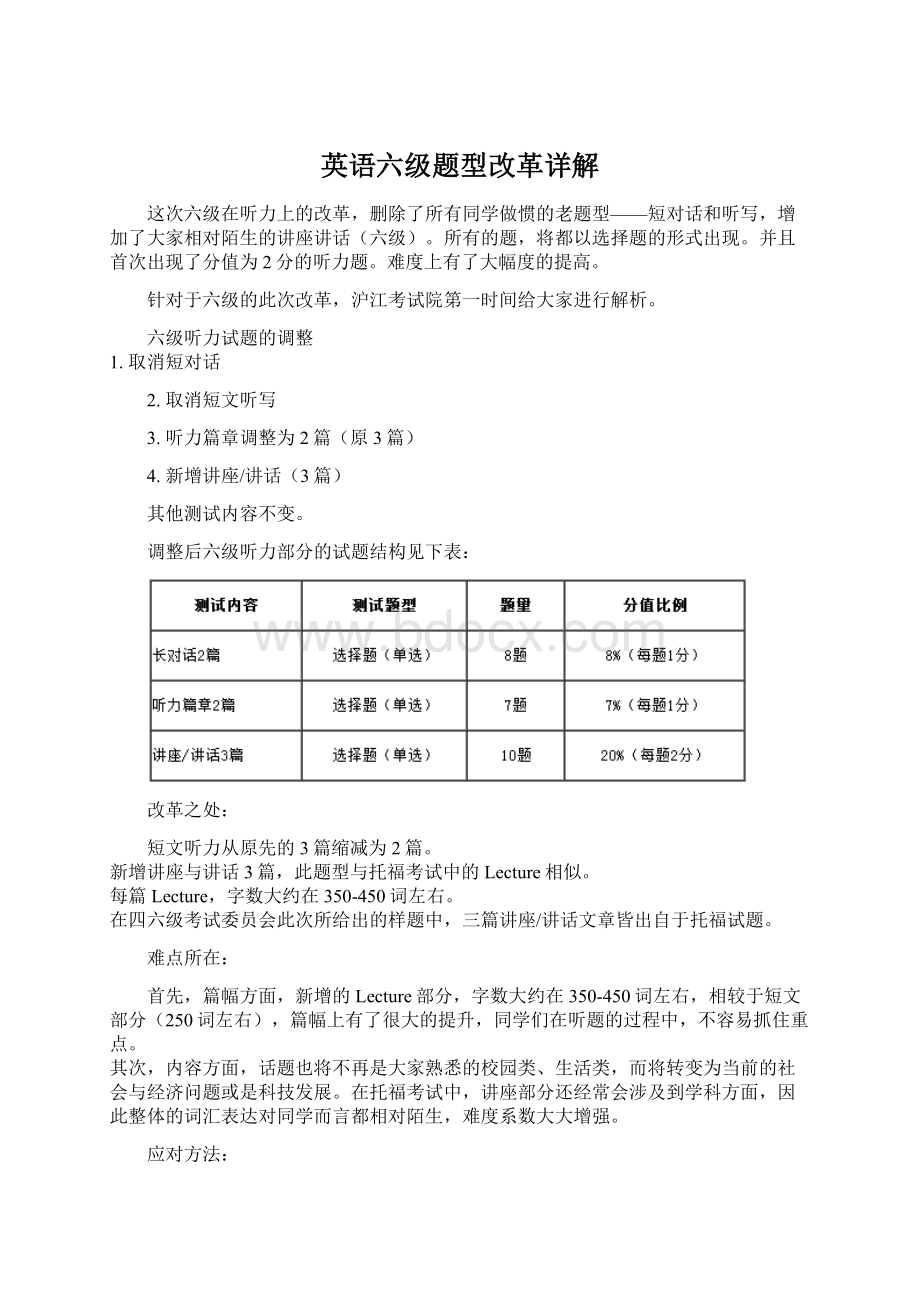英语六级题型改革详解.docx
《英语六级题型改革详解.docx》由会员分享,可在线阅读,更多相关《英语六级题型改革详解.docx(10页珍藏版)》请在冰豆网上搜索。

英语六级题型改革详解
这次六级在听力上的改革,删除了所有同学做惯的老题型——短对话和听写,增加了大家相对陌生的讲座讲话(六级)。
所有的题,将都以选择题的形式出现。
并且首次出现了分值为2分的听力题。
难度上有了大幅度的提高。
针对于六级的此次改革,沪江考试院第一时间给大家进行解析。
六级听力试题的调整
1.取消短对话
2.取消短文听写
3.听力篇章调整为2篇(原3篇)
4.新增讲座/讲话(3篇)
其他测试内容不变。
调整后六级听力部分的试题结构见下表:
改革之处:
短文听力从原先的3篇缩减为2篇。
新增讲座与讲话3篇,此题型与托福考试中的Lecture相似。
每篇Lecture,字数大约在350-450词左右。
在四六级考试委员会此次所给出的样题中,三篇讲座/讲话文章皆出自于托福试题。
难点所在:
首先,篇幅方面,新增的Lecture部分,字数大约在350-450词左右,相较于短文部分(250词左右),篇幅上有了很大的提升,同学们在听题的过程中,不容易抓住重点。
其次,内容方面,话题也将不再是大家熟悉的校园类、生活类,而将转变为当前的社会与经济问题或是科技发展。
在托福考试中,讲座部分还经常会涉及到学科方面,因此整体的词汇表达对同学而言都相对陌生,难度系数大大增强。
应对方法:
1.词汇积累:
除了原本六级听力高频词汇之外,同学们还可以开始对于托福听力的高频词汇进行一定的积累和背诵。
2.掌握Lecture规律:
同样作为正式文章,讲座/讲话的内容逻辑性强,结构清晰。
同学们在听题的过程中,明确内容的逻辑结构,对于提高正确率有很大的帮助。
通常,开篇会进行背景介绍以及话题引入;在正式的内容中,会从当前情况、面临问题、解决方法、未来展望等方面铺展开。
同学们可以与审题相结合,提高对于文章的把握。
3.着手练习:
由于新增题型源自于托福,因此同学们可以先从较为基础的托福lecture题目进行练习,熟悉题型。
平时,多收听收看TED演讲以及国外大学的公开课。
对于社会与经济方面的内容,多加关注,注重积累。
4.名师解析:
四六级改革,同学们也不要太焦虑,大家可以多关注四六级老师的深度剖析,具体请关注沪江考试院名师专栏,有问题也可以第一时间交流哦!
附:
改革后大学英语六级考试听力样题
PartIIListeningComprehension(30minutes)
2016年6月英语六级题型改革详解
作者:
沪江考试院 | 来源:
沪江英语
SectionA
Directions:
Inthissection,youwillheartwolongconversations.Attheendofeachconversation,youwillhearsomequestions.Boththeconversationandthequestionswillbespokenonlyonce.Afteryouhearaquestion,youmustchoosethebestanswerfromthefourchoicesmarkedA),B),C)andD).ThenmarkthecorrespondingletteronAnswerSheet1withasinglelinethroughthecentre.
ConversationOne
Questions1to4arebasedontheconversationyouhavejustheard.
1.A)Heinventedtherefrigerator.C)Hewasadmittedtoauniversity.
B)Hepatentedhisfirstinvention.D)HegotadegreeinMathematics.
2.A)Hestartedtoworkonrefrigeration.
B)He becameaprofessorofMathematics.
C)HefellinlovewithNatashaWilloughby.
D)Hedistinguishedhimselfinlowtemperaturephysics.
3.A)Discoveringthetruenatureofsubatomicparticles.
B)Theirexplanationofthelawsofcauseandeffect.
C)Theirworkonveryhighfrequencyradiowaves.
D)Layingthefoundationsofmodernmathematics.
4.A)Tohaveathree-weekholiday.C)Topatenthisinventions.
B)Tospendhisremainingyears.D)Toteachatauniversity.
ConversationTwo
Questions5to8arebasedontheconversationyouhavejustheard.
5.A)Theinjuryofsomestudents.
B)Aschoolbuscrashontheway.
C)Thecollapseofaschoolbuilding.
D)Afirethatbrokeoutonaschoolcampus.
6.A)Teaching.C)Havinglunch.
B)Onvacation.D)Holdingameeting.
7.A)Amalfunctioningstove.C)Violationoftrafficrules.
B)Cigarettesbuttsleftbyworkers.D)Negligenceinschoolmaintenance.
8.A)Sentastorytothelocalnewspaper.
B)ThrewasmallThanksgivingparty.
C)Bakedsomecookiesasapresent.
D)Wroteapersonalletterofthanks.
SectionB
Directions:
Inthissection,youwillheartwopassages.Attheendofeachpassage,youwillhearsomequestions.Boththepassageandthequestionswillbespokenonlyonce.Afteryouhearaquestion,youmustchoosethebestanswerfromthefourchoicesmarkedA),B),C)andD).ThenmarkthecorrespondingletteronAnswerSheet1withasinglelinethroughthecentre.
PassageOne
Questions9to11arebasedonthepassageyouhavejustheard.
9.A)Itisatraitofagenerouscharacter.C)Itisanindicatorofhighintelligence.
B)Itisareflectionofself-esteem.D)Itisasignofhappinessandconfidence.
10.A)Itwasself-defeating.C)Itwastheessenceofcomedy.
B)Itwasaggressive.D)Itwassomethingadmirable.
11.A)Itisadouble-edgedsword.C)Itisauniquegiftofhumanbeings.
B)Itisafeatureofagivenculture.D)Itisaresultofbothnatureandnurture.
PassageTwo
Questions12to15arebasedonthepassageyouhavejustheard.
12.A)Sheisatouristguide.C)Sheisadomesticservant.
B)Sheisaninterpreter.D)Sheisfromtheroyalfamily.
13.A)Itissituatedatthefootofabeautifulmountain.
B)Itwasusedbythefamilytoholddinnerparties.
C)Itwasfrequentlyvisitedbyheadsofstate.
D)Itisfurnishedlikeoneinaroyalpalace.
14.A)Itiselaboratelydecorated.C)Itisverybig,withonlysixslimlegs.
B)Ithassurvivedsome2,000years.D)ItisshapedlikeanancientSpanishboat.
15.A)Theyareinterestingtolookat.
B)Theyhavelostsomeoftheirlegs.
C)Theydonotmatchtheovaltableatall.
D)Theyareuncomfortabletositinforlong.
SectionC
Directions:
Inthissection,youwillhearrecordingsoflecturesortalksfollowedbysomequestions.Therecordingswillbeplayedonlyonce.Afteryouhearaquestion,youmustchoosethebestanswerfromthefourchoicesmarkedA),B),C)andD).ThenmarkthecorrespondingletteronAnswerSheet1withasinglelinethroughthecentre.
Nowlistentothefollowingrecordingandanswerquestions16to19.
16.A)TheyinvestigatetheretirementhomesinAmerica.
B)TheyareonissuesfacingseniorcitizensinAmerica.
C)Theydescribethe greatpleasuresofthegoldenyears.
D)Theyarefilledwithfondmemoriesofhisgrandparents.
17.A)Thelossoftheabilitytotakecareofhimself.
B)Thefeelingofnotbeingimportantanymore.
C)Beingunabletofindagoodretirementhome.
D)Leavingthehomehehadlivedinfor60years.
18.A)Thelossofidentityandself-worth.
B)Fearofbeingreplacedordiscarded.
C)Freedomfrompressureandworldlycares.
D)Thepossessionofwealthandhighrespect.
19.A)Theurgencyofpensionreform.
B)Medicalcareforseniorcitizens.
C)Findingmeaningfulrolesfortheelderlyinsociety.
D)Thedevelopmentofpublicfacilitiesforseniorcitizens.
Nowlistentothefollowingrecordingandanswerquestions20to22.
20.A)Itseriouslyimpactstheirphysicalandmentaldevelopment.
B)Ithas becomeaproblemaffectingglobaleconomicgrowth.
C)Itisacommonproblemfoundinunderdevelopedcountries.
D)Itisanissueoftenoverlookedbyparentsinmanycountries.
21.A)Theywilllivelonger.C)Theygetalongwellwithpeople.
B)Theygetbetterpay.D)TheydevelopmuchhigherIQs.
22.A)Appropriatedfundstopromoteresearchofnutrient-richfoods.
B)Encouragedbreastfeedingforthefirstsixmonthsofachild’slife.
C)Recruitedvolunteerstoteachruralpeopleabouthealthandnutrition.
D)Targetedhunger-reliefprogramsatpregnantwomenandyoungchildren.
Nowlistentothefollowingrecordingandanswerquestions23to25.
23.A)Theguaranteedqualityofitsgoods.
B)Thehugevolumeofitsannualsales.
C)Theserviceitprovidestoitscustomers.
D)Thehighvalue-to-weightratioofitsgoods.
24.A)Thosehavingatasteorsmellcomponent.
B)Productspotentiallyembarrassingtobuy.
C)Thosethatrequireverycarefulhandling.
D)Servicesinvolvingapersonalelement.
25.A)Thosewholiveinthevirtualworld.
B)Thosewhohavetoworklonghours.
C)Thosewhoareusedtoonlinetransactions.
D)Thosewhodon’tmindpayingalittlemore.
TapeScriptofListeningComprehension
SectionA
Directions:
Inthissection,youwillheartwolongconversations.Attheendofeachconversation,youwillhearsomequestions.Boththeconversationandthequestionswillbespokenonlyonce.Afteryouhearaquestion,youmustchoosethebestanswerfromthefourchoicesmarkedA),B),C)andD).ThenmarkthecorrespondingletteronAnswerSheet1withasinglelinethroughthecentre.
ConversationOne
W:
Hello.
M:
Hello,isthatthereferencelibrary?
W:
Yes.CanIhelpyou?
M:
Ihopeso.IrangearlierandaskedforsomeinformationaboutDenysHawtin,thescientist.Youaskedmetoringback.
W:
Oh,yes.Ihavefoundsomething.
M:
Good.I’vegotapencilandpaper.Perhapsyoucouldreadoutwhatitsays.
W:
Certainly.Hawtin,Denys.Born:
Darlington1836;diedNewYork1920.
M:
Yes.Gotthat.
W:
Inventorandphysicist.Thesonofafarmworker,hewasadmittedtotheUniversityofLondonattheageoffifteen.
M:
Yes.
W:
HegraduatedatseventeenwithafirstclassdegreeinPhysicsandMathematics.Allright?
M:
Yes,allright.
W:
Hemadehisfirstnotableachievementattheageofeighteen.Itwasamethodofrefrigerationwhicharosefromhisworkinlowtemperaturephysics.He becameprofessorofMathematicsattheUniversityofManchesterattwenty-four,whereheremainedfortwelveyears.Duringthattimehemarriedoneofhisstudents,NatashaWilloughby.
M:
Yes.Goon.
W:
Later,workingtogetherinLondon,theylaidthefoundationofmodernPhysicsbyshowingthatnormallawsofcauseandeffectdonotapplyatthelevelofsubatomicparticles.ForthisheandhiswifereceivedtheNobelPrizeforPhysicsin1910,anddidsoagainin1912fortheirworkonveryhighfrequencyradiowaves.InhislifetimeHawtinpatented244inventions.Doyouwantanymore?
M:
Yes.WhendidhegotoAmerica?
W:
Letmesee.In1920hewenttoteachinNewYork,anddiedtheresuddenlyafteronlythreeweeks.Still,hewasagoodage.
M:
Yes.Isupposeso.Well,thanks.
Questions1to4arebasedontheconversationyouhavejustheard.
1.WhatdowelearnaboutDenysHawtinwhenhewas15?
2.WhatdidDenysHawtindoattheageof24?
3.ForwhatwereDenysHawtinandhiswifeawardedtheNobelPrizeasecondtime?
4.WhydidDenysHawtingotoNewYork?
ConversationTwo
W:
ThisisLisaMeyerintheWBZnewsroom,talkingwithMikeBassichis,whoisthedirectoroftheGiffordSchool,aboutthecleanupfromlastweek’sfireandwhatthepossiblecauseofthatblazemayhavebeen.
M:
We’regettingreadyforourentirestafftoreturnearlyfromvacationtomorrowwhereuponwearegoingtomoveintotemporaryclassrooms.Andtheotherbuildingsthatdidnotburnarebeingde-smoked.Astothecauseofthefire,allweknowisthatwewerehavingtroublew